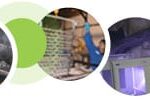In Part I, we discussed “What is clean?” and the harmful effects of unclean. In Part II, we will describe a simple suggestion to determine cleanliness that does not require or demand (as in the case of cleanliness specifications dictated by some processes) expensive laboratory equipment, clean rooms, etc. Pay Attention to the Water Break Free Surface Generally, the first and simplest sign we look for in a “clean” surface is a “water break free” part emerging from the rinse steps after the soak and electrocleaner. A water break free surface should have a coating of water, adhering across the … [Read more...]
Water and Your Plating Process
When it comes to cleaning and plating, there is one element which affects every single bath. This substance often makes up well over half of each tank, and we largely ignore it. That’s right, I’m talking about water. We put it in every bath, but pay no attention to what kind of water we have and what impact it will make. So let’s start at the beginning to understand how water effects the plating process. Types of Water That’s right; there are multiple types of water. These can be summarized into Hard, Soft, and Purified. Hard water is characterized by a high mineral content. Oftentimes, … [Read more...]
Conitinuous Learning in the Plating Industry
With more than 20 years in the plating industry I was surprised by how many insights and new pieces of information I picked up at the recent CEF course sponsored by Asterion in Indianapolis, IN. Here are just two of the applications regarding fixtures which were new to me. As I have talked with other industry "old timers" this was new information for them as well. I thought I'd share them and encourage you to attend the next CEF course sponsored by Asterion next year, you just might learn something to save your shop thousands of dollars. Barrel design: Traditionally it has been … [Read more...]
Basic Cleaning Fundamentals
Here is a simple truth “Nothing gets Plated until it gets Cleaned” Despite this simple truth, cleaning is often a neglected part of the metal finishing process. Here are some basic principles in metal preparation to follow to help you determine how well prepared the parts are in subsequent plating or finishing operations. Soak Cleaning Fundamentals Soak cleaners are used in simple tanks in which parts are immersed and then left to sit for a period of time. Typically soak cleaners are controlled by time, temperature and concentration. Used properly, soak cleaners should remove all of the … [Read more...]
Chromate Conversion Coatings
Zinc is typically used for the electrodeposited coating for iron and steel when prevention of atmospheric corrosion is the primary objective. However without a subsequent treatment, typically chromate, electrodeposited zinc becomes dull and grey and will quickly develop white corrosion products after exposure to air. Chromate conversion coatings impart both an aesthetically pleasing finish as well as varying degrees of corrosion protection. The use of Chrome VI in the conversion coatings as the passivation agent for zinc deposits are endowed with numerous advantages. These include: High … [Read more...]
Auxiliary and Ancillary Products
As our team of trained technicians and sales representative talks with metal finishing shops we notice many needs for chemicals which are not “plating” chemistries. These may include uses for general purpose floor cleaners, rust inhibitors or anti-splatter for welding. Clients are often surprised to learn we offer many good and effective chemicals for these applications. But these products don’t just appear in your shop without planning. How do you find the right product for your business? Well you could just type it into the computer and hope a search engine takes you to the correct … [Read more...]
Hard Chrome Plating
The process of hard chrome plating has been used since the early part of the 20th century. It is a process that is used in nearly every aspect of manufacturing where wear resistance and lubricity are critical. Typically coating thickness deposited are between 8 to 250 mm (0.00032”-.0098”) and hardness between 800-1000HV. High hardness and resistance to abrasion are retained unchanged up to 200o C. Early processes were standard chromic acid and sulfate processes. The late 1940’s gave to processes that used anions such as fluoride to improve plating rates and finish quality. Later evolution in … [Read more...]
